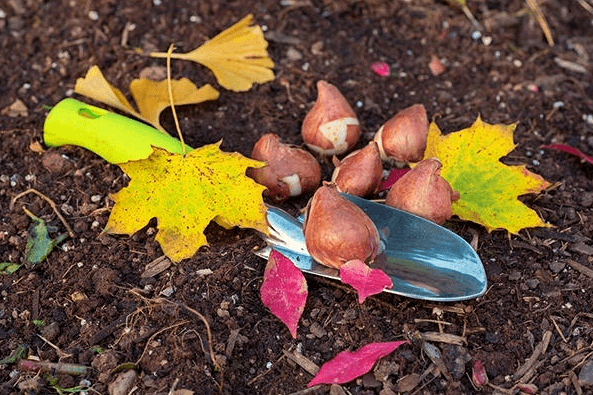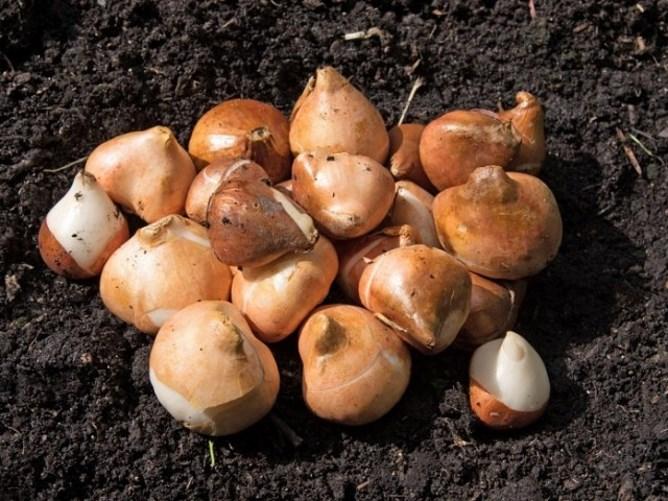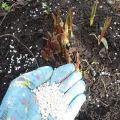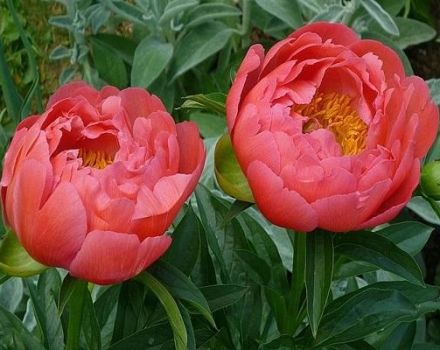How and how to process tulips before planting in the fall and whether it should be done
Spring is the time for the awakening of the plant world from hibernation. And the first bells among thawed patches are the appearance of bright tulips. In order for them to grow strong and bloom in the same season, it is necessary to prepare in advance, to process the tulip bulbs before planting in the fall. To do this, take out the products from the storage area, inspect, peel off, disinfect.
How and where to store bulbs before planting
Once the bulbs have been dug up, they are dried. Cleans from all debris: leaves, roots, dirt. Experienced gardeners recommend pickling tubers in a weak solution of potassium permanganate, especially if you plan to store products before winter.
- Long-term storage means periodic inspection of the bulbs. The damaged, rotten ones are thrown away.
- Spread on the surface in one layer and dry in the shade.
- Children are separated on day 5 and dried again.
- The kernels are placed in a box, each tuber is wrapped in paper or sprinkled with sawdust. This will prevent the accumulation of excess moisture.
- Containers are stored in the basement, refrigerator (vegetable compartment), unheated room, heat chamber on the balcony.
- Until autumn planting, they are kept at a temperature of 20 degrees Celsius.
- Before spring planting, the temperature is reduced to 17.
- To know exactly the storage conditions, to control, place a thermometer in the container.
What is pre-planting tulip bulbs?
The tulip tubers are taken out of storage and the bulbs are then prepared for planting.
Pre-planting tulip bulbs includes several stages.
- The products are cleaned from hard, dry skin.
- Each copy is carefully examined for diseases, rot, lethargy.
- Reanimate damaged specimens. Here it is up to the gardener to decide whether to soak diseased bulbs in a rescue solution or discard them immediately.
- The last stage is treatment with disinfectants right before planting.

Peeling bulbs from husks
The husk is removed on the day of planting. The top layer may contain foci of infection invisible at first glance. All dry scales are removed. So the plant will better absorb nutrients from the soil.
Close inspection
All tulip roots are poured onto the table after storage. Each tuber is examined carefully to detect rot, lethargy, and mechanical damage. All healthy and strong are left aside for now. Dealt with damaged copies. If there is an opportunity, they will reanimate, if not, they throw it out.

Sorting of planting material
As soon as the tulips are peeled off, proceed to sorting. Three containers should be prepared - for large, medium, small specimens.
For planting, tubers are needed large and medium. The latter are sent for growing. Of course, the work is troublesome and takes time. There is another option, without sorting - to purchase packets with prepackaged rhizomes at a flower shop.
How to disinfect tulip bulbs?
Before planting, tulips are treated with traditional substances: potassium permanganate, Fundazol. Experienced gardeners do not recommend the first method, as it is used after digging for storage. It is better to dip the material into the antifungal drug Fundazol. Dosage: 30 grams of the product are thrown into 10 liters of water.

Among the new drugs are drugs that are simultaneously growth stimulants:
- Fitosporin. The solution is prepared 2 hours before soaking. Dosage: for half a liter of water 10 grams of the product. 20 kilograms of products are soaked in this mixture.
- Maxim. Soak tulips for 30 minutes before planting. Solution: 2 liters of water, 4 milliliters of the drug. The mixture is designed for 2 kilograms of products.
- Epin extra. The drug has a third function - it activates all the protective properties of the plant. Dosage: for 2 liters of water 1 milliliter of the product. The solution cannot be kept in the sun. Withstand tulips for 1 day.
- Vitaros. The bulbs are placed in a solution for 2 hours (for 1 liter of water, 2 milliliters of the product).
The bulbs should be pickled and immediately planted carefully in open ground.

Processing lightly damaged bulbs
During the storage of bulbs, problems are possible:
- The increased temperature caused the tubers to shrivel. Such specimens cannot be planted in the ground. Nothing good will come of it. Even if shoots appear, the plant will be unhealthy. And this is a threat to the entire landing. In this situation, it is necessary to replenish the water balance of the bulb. To do this, prepare a solution of water with potassium permanganate 0.5%. Gauze is dipped into it and the damaged specimen is wrapped. Withstand 2 days - the planting material will take on its original form. Then they boldly plant it in the ground.
- It happens that the bulb is outwardly sluggish. Here potassium permanganate will not save. Take a growth stimulant, for example, Kornevin, Epin. Dilute it according to the instructions and lower the wilted tuber. After the planting material is restored, they are planted at the planting site.
- Soft onion. When pressed, juice flows. In this case, the planting material is thrown away - it is impossible to save it.
- Rotten spots on the tuber. This could be due to high importance. First of all, they clean off rotten areas to healthy tissue. Treat the wound with brilliant green. Damaged specimens are placed in a damp cloth for a day. Then they are transferred to wet sand until complete recovery for 2-3 days. The last procedure is sun drying.
- Frozen bulbs. According to the instructions, a growth stimulator is diluted and the damaged elements are lowered for a day. Then the bulbs are poured with dry peat and sent to the refrigerator for another 24 hours. Only then can you plant it in a flower bed.
- Gray bloom on the surface of the tuber. This may be a disease of fusarium. The plaque is cleaned off with a knife and treated with a special preparation. Fungicide is sprinkled on the affected area and left for 2 days. During this time, a cork film forms.
All resuscitation procedures should be applied to rare varieties. In other cases, it is better to get rid of the damaged instances.

Is it worth fertilizing the land
Tulips can be grown without top dressing. Only in the second year will they be too different from their counterparts, who are fed. The flowers will be smaller, the stem is thin, the plant is susceptible to diseases, since the immune system is weakened.
Only in fertile soil do tulips feel good, but plants greatly deplete the soil, draw out all the nutrients from it, therefore, four additional fertilizing are required in a short vegetative period - 2 months.
Flowers need a complex of fertilizers: nitrogen, potassium, phosphorus, in various proportions. Nitrogen is responsible for building up green mass, potassium helps to quickly take root, phosphorus is involved in the formation of buds. At each stage of feeding, one of the components is in the lead.
Microfertilizers with the presence of elements are no less important for flowers: nickel, iron, boron, zinc, manganese, copper.
Although they are required in micro doses, they bring considerable benefits to the plant:
- form a strong stem, large inflorescences;
- strengthen the immune system;
- participate in metabolic processes and photosynthesis;
- resist diseases, pests;
- increase frost resistance.

Microfertilizers are introduced with the help of foliar feeding. The fertilizer set depends on the season. When planting in autumn, top dressing is chosen that act on rapid rooting, protection from external factors. In spring, components are needed for the growth of green mass (leaf, stem), root.
Tulips are grown at home for distillation. Here you do not need to make a lot of dressings, since another task is being performed - rooting the bulbs. Before planting, you only need to add a solution of calcium nitrate to the soil. The rest of the care consists in choosing a cool temperature, humidity, watering.
As a conclusion
As you can see, simply pulling tulips out of storage and planting them in open ground is not enough. To teach large, healthy buds, you have to try. Go through certain steps before planting: peel, sort, disinfect the bulbs.









